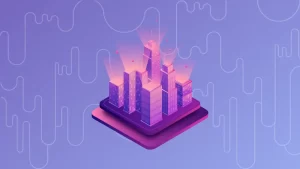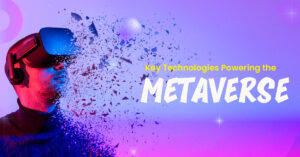Once a science fiction phenomenon, the metaverse is fast becoming a reality thanks to rapid technological breakthroughs. It is a fully immersive digital world where users can interact with each other and with digital environments in real time using virtual and augmented reality technologies. As the metaverse continues to expand, it has found countless practical applications across a wide range of industries. These apps are changing the way people work, learn, socialize, shop, and more. As businesses and individuals continue to explore its potential, the metaverse is proving to be more than a fad—it’s defining the future of our everyday experiences.
Education and Virtual Learning Environments:
One of the most promising applications of the metaverse is in education. By using avatars, virtual campuses, and 3D simulations, virtual classrooms are becoming more engaging and immersive. Instead of just reading a textbook or watching a movie, students can visit historical sites, conduct scientific experiments, and improve their language skills in a real-world environment. Teachers can design engaging lessons that mimic real-world scenarios, making learning more dynamic. This approach could benefit not only traditional education systems but also corporate training, medical schools, and distance learning platforms, making education more inclusive and accessible to everyone.
Remote Work and Virtual Offices:
The rise of remote work has created a need for more efficient online communication and collaboration tools. The metaverse provides a solution by creating a virtual workplace environment where employees can interact with each other via avatars. Meetings, brainstorming sessions, and informal coffee break chats can all take place in a shared digital environment, making teams feel more connected even when they are not physically together. Metaverse tools allow users to share documents, use virtual whiteboards, and easily connect via gestures and voice. This feature improves productivity, creativity, and team cohesion, especially in companies with a global workforce.
Healthcare and Medical Education:
Healthcare is another area where the Metaverse is having a significant impact. Medical professionals are using virtual environments for training, allowing students and clinicians to perform procedures in a safe and controlled setting. These simulations can mimic real-life situations, such as surgery or emergency care, so patients can hone their skills while staying safe. Additionally, the metaverse is being used for healing and rehabilitation. Patients with physical or mental health issues can receive virtual therapy, exposure therapy, or guided exercises from the comfort of their own home. It also enables teleconsultations, making healthcare more accessible to people in rural or underdeveloped areas.
Shopping and Virtual Shopping Experiences:
The metaverse is redefining the shopping experience. Retailers are creating virtual stores where customers can browse products as if they were in a physical mall. Customers can try on clothes in virtual fitting rooms, view products from all angles, and receive personalized recommendations based on their digital avatar. These interactions are often more engaging than standard e-commerce because they combine convenience and engagement. Brands are also using the metaverse for product launches and exclusive virtual events to generate buzz and engage tech-savvy audiences. The result is a more engaging and enjoyable online shopping experience.
Real Estate and Virtual Tours:
In real estate, the metaverse is enabling new interactions between buyers, sellers, and agents. Virtual tours allow potential buyers to view a home, apartment, or commercial property without having to go there in person. They can navigate through rooms, open doors, and see things in high quality. The feature is especially useful for overseas clients or those moving to a new city. Developers and architects are also using VR to demo projects before construction begins. The technique allows investors and clients to see the result. It saves time and money and improves the decision-making process.
Recreational and Immersive Activities:
Entertainment is one of the most obvious uses for the metaverse. Millions of people watch virtual concerts, movie premieres, and interactive events. Artists and producers can perform in specially designed virtual locations, allowing fans from all over the world to attend the event without having to fly. Video games are increasingly evolving into social platforms where users can participate in events, connect with friends, and personalize their experience in addition to playing games. The metaverse creates a platform where people can participate in entertainment rather than just consume it. From music festivals to comedy shows, the possibilities for immersive events are endless and ever-expanding.
Social and Digital Communities:
The metaverse relies heavily on social interactions. People develop connections, communities, and even romances in virtual places. These platforms offer more than just text or video chat; they enable real-life interactions through avatars and virtual environments. Users can socialize in real and meaningful ways, such as attending parties, visiting virtual beaches, or participating in group activities. For those who are shy, geographically isolated, or physically challenged, the metaverse provides opportunities for interaction and belonging. These communities are often welcoming and diverse, allowing individuals to express themselves freely and creatively.
Tourism and Virtual Travel:
Travel is another area where the metaverse offers unique experiences. Virtual tours allow users to visit iconic landmarks, museums, and natural wonders anywhere in the world. Not only is this a great way to organize a field trip, but it also provides an option for those who are unable to travel due to financial, physical, or other limitations. Museums and historical sites offer comprehensive virtual tours with educational content and interactive features. Travel companies are now using the metaverse to promote destinations, giving potential tourists a sneak peek before they book a trip.
Finance and Digital Transactions:
Financial services companies are adapting to the metaverse by offering digital banking, cryptocurrency management, and virtual investment options. Users can visit a virtual bank branch, speak with an advisor, and manage their accounts in a secure and user-friendly environment. Blockchain technology makes digital transactions secure and transparent. Cryptocurrencies are often used on metaverse platforms to purchase virtual items, land, and services. Some companies are also developing financial education programs based on the metaverse to teach users about budgeting, investing, and ethical financial management. Integrating finance into the metaverse improves transaction efficiency and creates new economic opportunities.
Manufacturing and Industrial Training:
Metaverse is used for training, design, and operations in the manufacturing industry. Employees can learn to operate complex machinery, learn processes, and follow safety regulations in a virtual environment without having to deal with real-world hazards. Engineers and designers use virtual simulations to test new products or production processes, saving time and resources. Digital twins, virtual versions of physical assets, provide real-time monitoring and troubleshooting. The metaverse improves the efficiency, accuracy, and safety of industrial work, driving productivity and innovation across the supply chain.
Conclusion:
The metaverse is not just a futuristic concept; it is already transforming real industries in a big way. Its applications are broad and far-reaching, spanning sectors such as education, healthcare, retail, real estate, and finance. These digital environments provide immersive, interactive experiences that improve the way we live, work, and communicate with each other. As technology advances, the metaverse will become more integrated into our daily lives, bringing new opportunities and challenges. Understanding how virtual and physical reality work in the real world can help us prepare for a future where these realities seamlessly merge and enhance our experiences.
FAQs:
1. What industries are currently using the metaverse?
Industries such as education, healthcare, real estate, entertainment, retail, and finance are already using metaverse technologies to improve services and user experiences.
2. Can the metaverse be used for hands-on education and training?
Yes, the metaverse can be used in virtual classrooms, medical training, industrial simulations, and other applications that enable hands-on learning in a safe, regulated environment.
3. Does virtual shopping currently exist in the metaverse?
Yes, many companies are experimenting with virtual stores where customers can view, try on, and purchase products using avatars and digital payment methods.
4. How can the metaverse support healthcare?
It is being used for virtual consultations, physical rehabilitation, and training simulations, making healthcare easier and more efficient.
5. Will the metaverse replace the physical experience?
Not entirely. While physical contact is enriching and complementing daily activities, many people still value it. The metaverse is all about providing new possibilities and improving our current lives.




